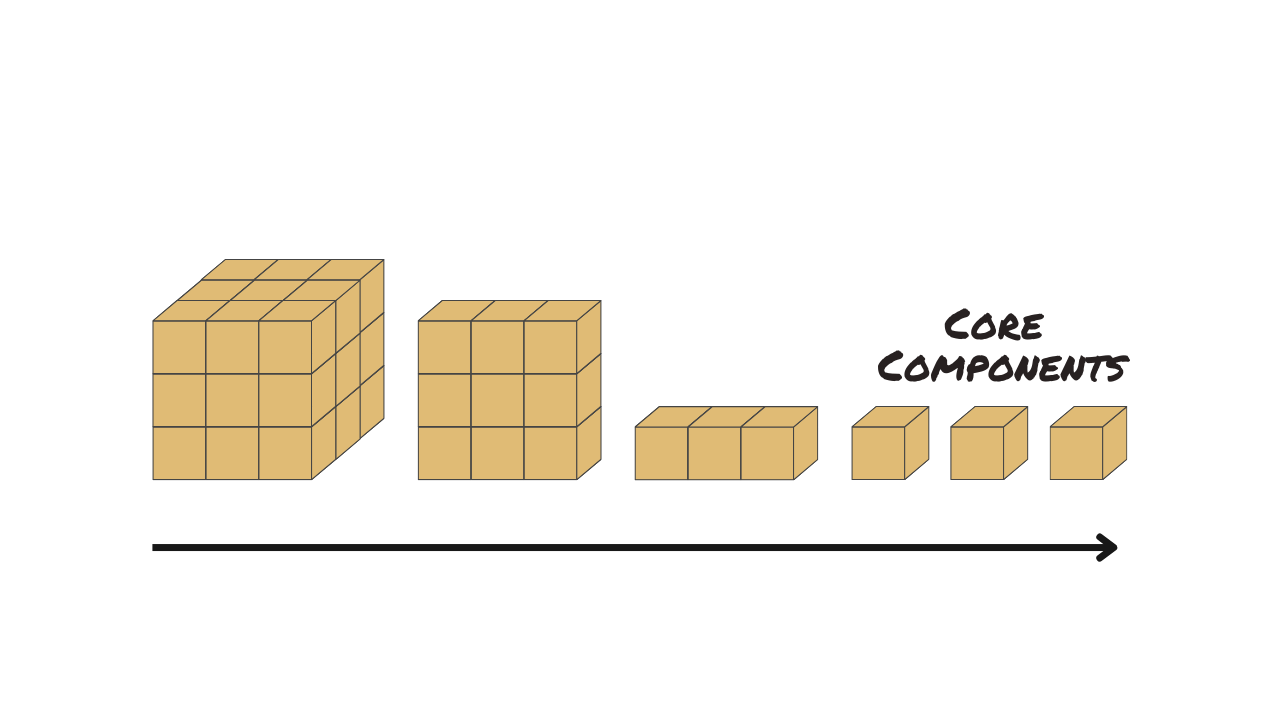What Is First Principles Thinking?
First principles thinking is about breaking things down to their most fundamental elements; removing assumptions, biases, and conventional beliefs. It’s the foundation for clear reasoning. Instead of taking things at face value, it forces you to ask: What do I know for sure?
Think of it like learning multiplication. If a person is only taught to memorize that 7x7 is 49, then they might know the answer, but struggle if given a new problem, like 7x150. A mathematician, on the other hand, doesn’t just memorize, they understand the concept behind multiplication, which enables them to break it down, work through it, and arrive at the answer logically. First principles thinking applies this same process to decision-making, problem-solving, and creativity.
Most people rely on analogy-based thinking, where they do something because it’s how it has always been done. First principles thinking forces you to challenge this, breaking problems into core components and rebuilding them from the ground up.
How First Principles Thinking Fuels Creativity

Imagine being handed a box of LEGO bricks. Some people would follow the instruction manual step by step, copying the design given to them. Others would dump the pieces out, analyze the core components, and build something completely original. That’s the difference between conventional thinking and first principles thinking.
Creativity is not about copying, it’s about deconstructing an idea to its most basic elements and then reconstructing it in new ways. This is why first principles thinking is so powerful in innovation.
Take business, for example. Most companies operate under industry norms, following the same pricing structures, marketing strategies, and operational models as their competitors. But true disruption happens when someone steps back, breaks the model into its core components, and builds something entirely new. By identifying constraints and challenging the given rules, first principles thinkers create breakthroughs instead of iterations.
Breaking the Mold with a Real World Example
Look at the electric car industry. Before Tesla, automakers followed the same model of using internal combustion engines, dealership networks, and slow adoption of new technology. Many dismissed electric cars as unfeasible because batteries were too expensive and had limited range.
Elon Musk applied first principles thinking: Instead of accepting that batteries were too costly, he broke down the problem. What are batteries made of? Lithium, nickel, cobalt, and graphite. By analyzing the raw materials and their true costs, Tesla was able to innovate on battery production, reduce costs, and build electric cars that changed the vehicle industry.
The lesson is most people accept things as they are. First principles thinkers reverse engineer and break things down, giving them a deeper understanding of complex problems, which allows them to ask better questions and derive better solutions.
Enjoying the Read?
Weekly Mindset Newsletter
Get personal stories, decision-making strategies, and mental frameworks to help you stop overthinking, build self awareness, and live with more clarity.
Thank you!
What is the Socratic Method?
So how do you train your mind to think this way? One of the most effective tools is the Socratic method, a questioning technique that challenges assumptions and deepens understanding.
2. Assumptions: What assumptions am I making? Are they valid?
3. Evidence: What evidence supports my thinking? Is it reliable?
4. Alternative Views: What if I looked at this differently? What would someone else argue?
5. Implications: What are the consequences of this approach? Does it align with my goal?
- Am I assuming I need to start over, or can I transition within my current field?
- What real evidence do I have that switching careers will make me happier?
The Socratic method, named after the philosopher Socrates, is about asking disciplined questions that force you to examine your reasoning. Instead of accepting things at face value, it makes you dig deeper.
When facing a problem or decision, use these five key Socratic questions:
1. Clarification: What exactly am I trying to solve? Do I understand it fully?
2. Assumptions: What assumptions am I making? Are they valid?
3. Evidence: What evidence supports my thinking? Is it reliable?
4. Alternative Views: What if I looked at this differently? What would someone else argue?
5. Implications: What are the consequences of this approach? Does it align with my goal?
As an example, let’s say you’re considering changing careers. Instead of saying, “I need to find a new job,” the Socratic method would have you ask:
- What do I actually want from a career?
- Am I assuming I need to start over, or can I transition within my current field?
- What real evidence do I have that switching careers will make me happier?
By questioning assumptions, you gain clarity and make better decisions.
Techniques for How to Think From First Principles
Developing a first principles mindset requires questioning everything. Here are some techniques to apply first principles thinking in your own life:
Ask Why (Multiple Times)
If you’re told something is true, ask why? If the answer isn’t based on fundamental truths, ask why again. Do this enough times, and you’ll get to the core of the issue.
Example: If someone says, “We have to do marketing this way because it’s how it’s always been done,” challenge it. Why does this method work? Are there better alternatives?
Break Things Down Into Core Components
Reverse-engineer problems. Instead of looking at something as a whole, deconstruct it into its basic elements.
Example: Instead of accepting that a product costs a certain amount, analyze its individual materials and manufacturing process. Could there be a better way?
Challenge Authority and Common Beliefs
Many people follow rules without questioning if they still make sense. Just because something is widely accepted doesn’t mean it’s optimal.
Example: Galileo challenged the belief that the Earth was the center of the universe. He questioned the prevailing knowledge and proved a new, more accurate model.
Test Your Assumptions
Don’t assume something is correct just because it’s common knowledge. Test it. Look for data, run experiments, and be willing to change your mind.
Example: Business owners often assume they need a massive budget for advertising. But what if unconventional, low-cost marketing works better?
Adopt an Open Mindset
First principles thinking requires the humility to admit when something isn’t working and the willingness to pivot.
Example: Blockbuster assumed physical rentals would always be dominant. Netflix questioned that assumption and built a new model around streaming. The result? Blockbuster was no longer competitive and collapsed.
Building a Foundational Mindset
First principles thinking and the Socratic method are mental models that focus on one thing: how to think effectively. Instead of being limited by old models, you develop a foundational mindset that helps you approach problems with fresh eyes.
The world rewards those who can see through assumptions, deconstruct them, and generate alternative solutions. This mindset isn't just for scientists or entrepreneurs, it’s useful in everyday life.
While most people accept the world as it is, first principles thinkers shape the world into what it could be. The difference isn’t intelligence—it’s perspective. By stripping problems down to their core elements and questioning assumptions, you gain the ability to think independently, solve complex challenges, and make better decisions.
When you break free from outdated norms and unlock creativity, this prevents you from just following instructions blindly. It gives you the opportunity to ask if there’s a better way, challenge dated beliefs, and ultimately enhance your decision framework from the ground up.
So the next time you face a problem, don’t ask, What has always been done? Instead, ask, What is fundamentally true?
Sincerely,
Sincerely,
Dexter Lam
Mental Models
Want to explore more mindset frameworks for optimizing your decision-making?

Do you want to level up and change your life Trajectory?
We're launching our course on Self-Awareness
Thank you!

